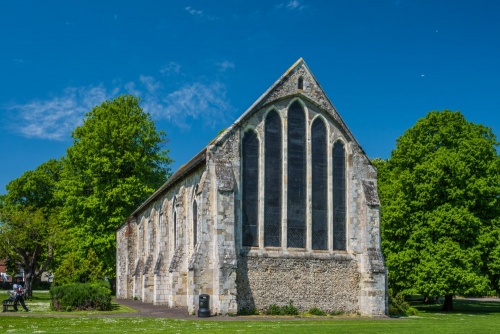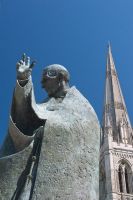
History
When the Romans arrived in 43 AD under Emperor Claudius, they found an existing settlement of the pro-Roman Atrebates tribe, led by their client king Cogidubnus. The Romans established Noviomagus Reginorum ("new market of the proud people/kingdom") as a civilian settlement rather than a military fortress, which was unusual for early Roman Britain.
Cogidubnus became a key Roman ally, and his influence is evidenced by the magnificent Fishbourne Roman Palace, discovered in 1960 just west of Chichester. Built around AD 75, it was one of the largest and most luxurious Roman residences north of the Alps, featuring elaborate mosaics, marble-clad walls, and sophisticated underfloor heating systems.
The site occupied by a 1st-century Roman amphitheatre can be found at the east end of the city centre.

Chichester Cathedral
The magnificent medieval cathedral was built on the site of a Roman building and a later Saxon church, and incorporated stones from the earlier buildings, plus several Saxon carvings. Unusually, the cathedral has a detached bell tower, something that is fairly common on the continent, but rare in Britain.
The interior features some fine 14th-century choir stalls, and two superb Norman carvings; the Raising of Lazarus, and Christ Arriving in Bethany, both on the south wall.
In the centre of the city stands the Market Cross, built in 1501 on the site of an earlier timber-framed market building to provide a place for poor merchants to sell their produce.

One of the best preserved historic buildings is the almshouse known as St Mary's Hospital, which has remained essentially unaltered from its construction in the 13th century. It is perhaps the oldest almshouse in the world to be continuously in use.
Another Chichester highlight is the medieval Guildhall, built in 1282 as the chancel of a Franciscan friary. The Guildhall was the scene of high drama in 1804 when the artist and poet William Blake was tried and acquitted of high treason.
The Guildhall stands a stone's throw from an 11th-century castle mound of Chichester Castle, erected shortly after 1066 by Earl Roger of Shrewsbury, one of the most powerful Norman lords in England.
The 15th-century church of St Andrews is less grand than the neighbouring cathedral, but in the churchyard you can find the grave of William Collins, who died of madness in 1759.

In a fine red-brick Georgian house on Pallant Square is one of the best art galleries outside London, Pallant House Gallery, where you will find works by Picasso, Cezanne, and Henry Moore, among others.
Long stretches of the Roman city walls have survived. These were strengthened and rebuilt several times during the medieval period, and today, several stretches of the wall are accessible for walking.
The city is connected to the sea by the Chichester Ship Canal, built in 1822? as part of an ambitious scheme to link Portsmouth to London via inland waterways. You can walk along the towpath from Chichester Bason, along the canal, to Birdham on the coast. Artist JMW Turner painted the scene looking along the canal to the spires of Chichester Cathedral in 1829.
Just a few miles from Chichester is the Goodwood estate, site of 'Glorious Goodwood' an annual horse racing event that is one of the major highlights of the British sporting and social calendars.










 We've 'tagged' this attraction information to help you find related historic attractions and learn more about major time periods mentioned.
We've 'tagged' this attraction information to help you find related historic attractions and learn more about major time periods mentioned.


